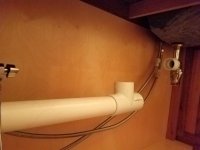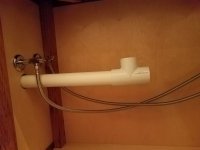gwills
New Member
I am installing a one piece bathroom counter/sink. This is a remodel and the existing iron pipe is in the wall that is 36" to the left of the sink tail piece. A studor valve will provide make-up air. My original plan was to run 1.5" sch 40 PVC from the elbow on the iron pipe to a T with a AAV and another piece of PVC that will terminate in a 1.5 x 1.25 metal P trap. A 12" tail piece should be long enough for the proper 1/4" slope. The problem is that the 1.5" PVC is dead level. What is the best way to get the required slope?
Thank you in advance for any advice.
Gene
Thank you in advance for any advice.
Gene


